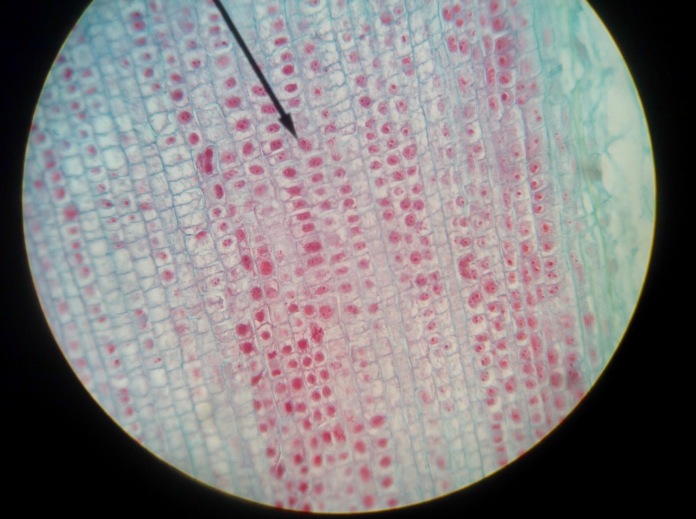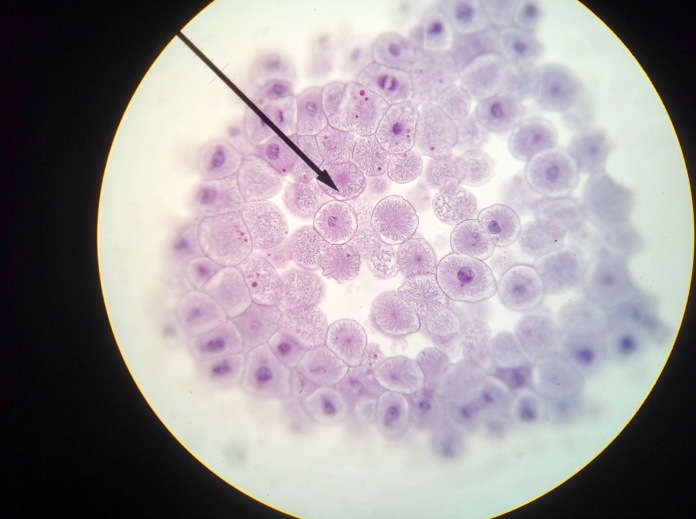Effects of Environment on Mitosis Postlab Review Answers
Introduction and Objective
In Mr. Wong's 7th period bio-honors class, we did a lab experiment on the processes of mitosis and the different phases every bit seen nether a microscope. The objective of this experiment was to summate the percentage of cells in each of the phases of mitosis.There were two different slides, one of onion root tip and one of whitefish blastula. The slides were each placed under a microscope and observed. The stages were counted, and the percentages were calculated.
Experiment Question
What is the frequency of each of the stages of mitosis? Is time in each stage a factor of how frequently the phases appear?
Hypothesis
If the per centum of phases is calculated, the percentage of cells in interphase will exist the greatest because cells spend nearly of mitosis in interphase. The results will prove that the about cells are going through interphase and that interphase takes the majority of the time of mitosis.
Materials
- Microscope from Mr. Wong'south lab
- Onion root tip microscope slide
- Whitefish Blastula microscope slide
- Photographic camera
Procedure
- Prepare microscope.
- Put in Onion root tip slide.
- Observe the magnified cells.
- Take a picture using camera.
- Echo steps 2 and 3 using Whitefish blastula slide.
- Take a picture using camera .
- Open up pictures and count cells in each stage of mitosis.
- Calculate percentage of each phase
- Calculate the per centum of fourth dimension spent in each phase

This is how I counted each of the cells.
Results
The picture of the Onion root tip contains more twice as many cells equally the whitefish blastula, so my results comprise 2 fields of Onion root tip and ane field of Whitefish Blastula. Interphase was the almost common phase. In addition, blastula have a smaller partitioning calibration than root-tips; root-tip jail cell samples contain many more cells than blastula samples. Withal, they were observed at the same magnification power. So, it shows that far more onion cells were observed.
Onion root tip slide:


Whitefish Blastula slide:

The time in each stage was calculated with this formula:
Percent of cells in phase x 1440 minutes = minutes of cell cycle spent in stage

A Pie graph with the percentages and jail cell counts:

Analysis
3A.
- Why is it more authentic to call mitosis "nuclear replication" rather than "cellular division"?
- It is more than authentic to say that the nucleus is existence replicated, rather than saying that the cell is being cleaved into 2 pieces. The nucleus is replicated rather than cutting in half; thus, the term "nuclear replication" is more than authentic than "cellular partition".
- Explain why the whitefish blastula and onion root tip are selected for a study of mitosis.
- Blastula and root tips are where the creation of new cells happens. That is where the cells split up and is where nuclear replication is the nearly frequent.
3B
- If your observations had not been restricted to the area of the root tip that is actively dividing, how would your results have been dissimilar?
- The full number of cells in mitosis would take been lower, thus lowering the sample size. The accuracy of this experiment depended on the sample size because it is dealing with cells. Likewise, It would be harder to find the phases that were rarer than Interphase.
- Based on the data in the Table, what can you infer about the relative length of fourth dimension an onion root-tip prison cell spends in each stage of jail cell division?
- A cell spends nearly lxx% of its fourth dimension in cell division in Interphase. And so, afterwards grooming, it goes through Prophase for virtually 15% of the time in jail cell segmentation. Next, information technology spends 3% in Metaphase, ten% in Anaphase, and 5% in Telophase.
Determination
In determination, this experiment was successful. The hypothesis was correct. Interphase took up threescore% of the fourth dimension in nuclear replication, having a much college count than all of the other phases. All of the observations went smoothly and the data was recorded well. The entire experiment taught me nigh Mitosis and the length of different phases in prison cell division. Root tips and blastula are where cells most actively divide and form new cells. According to my experiment of 250 cells, I learned that it takes nearly 24 hours to full replicate one prison cell. If mitosis did not happen in this fashion, who know what may accept happened to early on cells and organisms? Clearly, this experiment provided self-information, exploration, and insight into the study of cells and nuclear replication/mitosis.
Standard
Source: https://mattbiowong.wordpress.com/2015/01/14/mitosis-lab-report/
0 Response to "Effects of Environment on Mitosis Postlab Review Answers"
Post a Comment